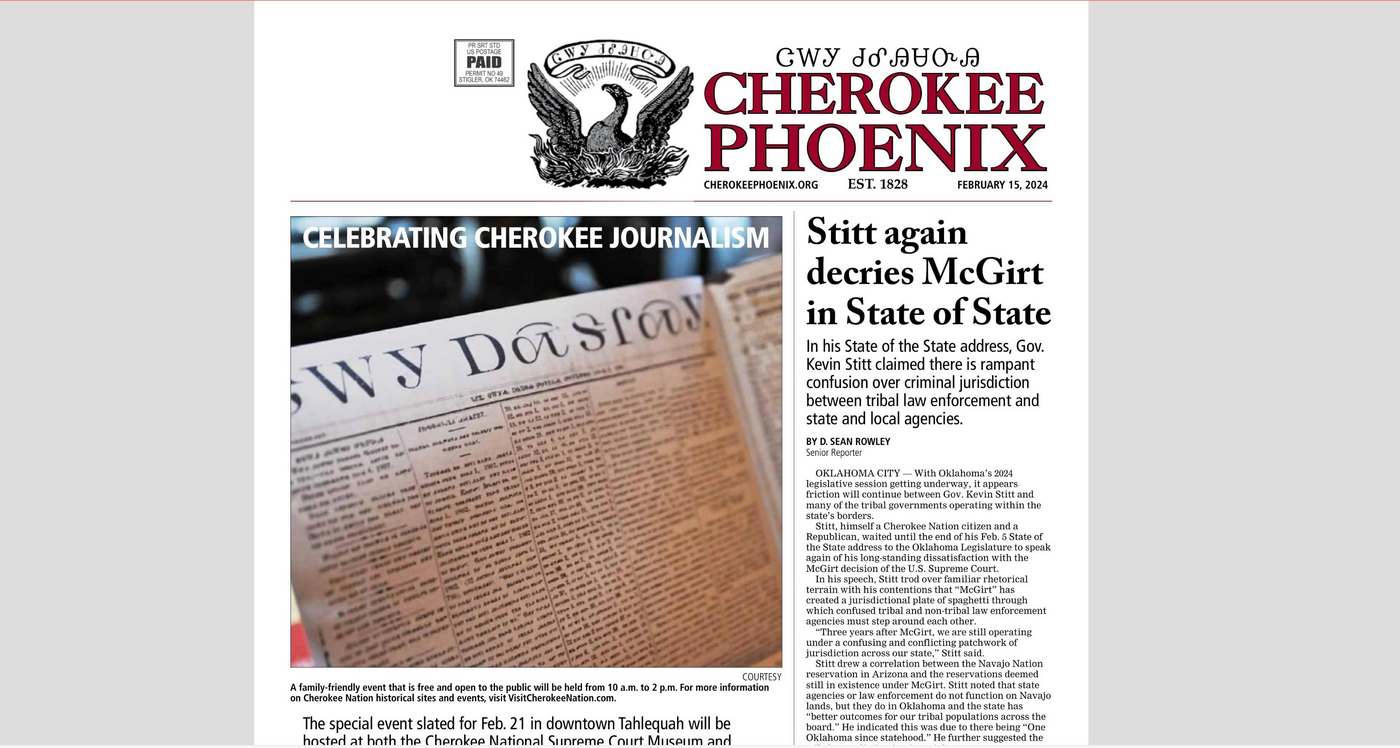196 years ago today, the first issue of the Cherokee Phoenix was published using the Cherokee syllabary invented by Sequoyah. Sequoyah, also known as George Gist, was a Cherokee polymath who was one of the few people in history from a pre-literate group who created the original written system for that group’s language. Just as Sequoyah’s Cherokee language is still in use, the Cherokee Phoenix is still in print today, nearly 200 years after its first publication. READ more about its origins… (1828)
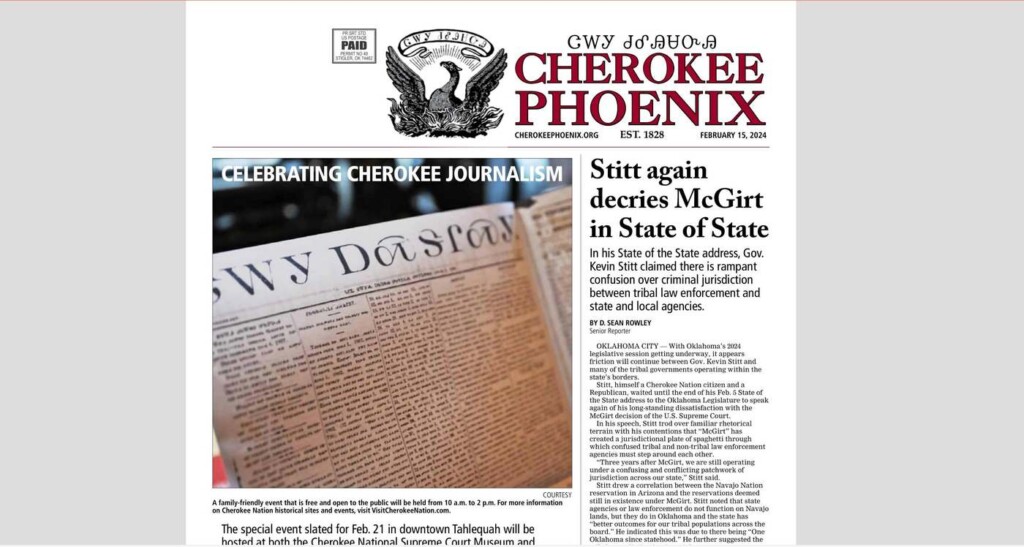
The Phoenix was the first newspaper published by Native Americans in the United States and the first published in a Native American language. Those who could only read Cherokee received the paper for free, while those who could read English paid $2.50 a year.
It contained five columns on each of its four pages. The editor, Elias Boudinot announced that, because translation between English and Cherokee was slow, initially the paper would print only three columns each week in the Cherokee language. The first issue covered a variety of subjects. Samuel Worcester wrote an article praising Sequoyah’s invention of the syllabary, and Boudinot’s first editorial criticized white settlers wanting Cherokee land.
As the issue of removal from their lands in Georgia attracted attention in the United States, the newspaper arranged a fund-raising and publicity tour, which attracted new subscribers from almost all areas of the US and Europe.
Eventually, as the government conspired to steal their land, they ceased paying the annuity due to the Cherokee and the paper ceased publication in 1835. It was eventually revived in the 20th century from the Cherokee’s exile in Oklahoma. In the 21st century, artists Jeff Marley and Frank Brannon completed a collaborative project on October 19, 2013, in which they printed using Cherokee syllabary type in the print shop at the original capital of the nation at New Echota, Georgia. This was the first time syllabary printing type was used at New Echota since 1835.
MORE Good News on this Date:
- Jeanne Calment was born in Arles, France and lived there for more than 122 years—the longest confirmed human lifespan in history (1875)
- The newly completed Washington Monument was dedicated (1885)
- The New Yorker published its first issue as a sophisticated humor magazine, and soon began featuring serious fiction and journalism (1925)
- First successful flying car, Waldo Waterman’s Arrowbile made its maiden flight (1937)
- Edwin Land demonstrated the first “instant camera,” his Polaroid Land Camera, which produced a black-and-white photo in 60 seconds (1947)
- Winston Churchill helped abolish Identity Cards in the UK to “set the people free” (1952)
- Four student demonstrators became martyrs as they demanded to establish Bangla as the official language of East Pakistan, sparking a movement that led to the independence of Bangladesh in 1971—a date later declared International Mother Language Day by UNESCO (1952)
- Francis Crick and James Watson arrived at their historic understanding of the structure of DNA (1953)
- The Jackson 5 were introduced to the nation with their first appearance on American Bandstand, when 11-year-old Michael sang “I Want You Back” (1970)
- Israeli soldiers left the Suez Canal’s west bank honoring a truce with Egypt (1974)
- Metallica released their third album, the highly influential Master of Puppets, considered by many in the music community to be the best thrash metal album of all time (1986)
76 years ago today, the National Association for Stock Car Auto Racing, LLC (NASCAR) was established in Daytona Beach, Florida. The American racing circuit was incorporated by Bill France who had moved to Florida to escape the worst of the Great Depression. France had the notion that people would enjoy watching stock cars race. Drivers were frequently victimized by unscrupulous promoters who would leave events with all the money before drivers were paid. On December 14, 1947, France began talks with other influential racers and promoters at the Ebony Bar at the Streamline Hotel in Daytona Beach, Florida, which ended with the formation of NASCAR.

The first NASCAR “Strictly Stock” race ever was held at Charlotte Speedway. Initially, the cars were known as the “Strictly Stock Division” and raced with virtually no modifications on the factory models. This division was renamed the “Grand National” division beginning in the 1950 season. Over a period of more than a decade, modifications for both safety and performance were allowed, and by the mid-1960s, the vehicles were purpose-built race cars with a stock-appearing body.
The NASCAR Cup Series (NCS) is the sport’s highest level of professional competition. It is consequently the most popular and most profitable NASCAR series. Since 2001, the Cup Series season has consisted of 36 races over 10 months. The record for most championships is 7, held by three drivers: Richard Petty, Dale Earnhardt, and Jimmie Johnson. (1948)
52 years ago today, in one of the finest acts of international diplomacy ever undertaken by an American President, Richard Nixon went to China, shook hands with the Reds, and ushered in a new era of U.S.-China relations that proved to be one of the two or three key moments in the peaceful ending of the Soviet Union and the Cold War. Showing the power of a simple act of mutual respect and goodwill, regardless of one leader’s opinions about another’s, the go-and-shake-hands approach worked like a charm and has been a model of diplomacy ever since. Nixon would say in the careful build-up to the meeting that “there is no place on this small planet for a billion of its potentially most-able people to live in angry isolation.”

Nixon was the first president to visit the People’s Republic of China (PRC) and it ended a 25-year period with no diplomatic relations. It created a moment in which it suddenly became okay for Republicans to cheer on diplomacy. This has actually been dubbed the “Nixon to China” moment, a metaphor for the ability of a politician with an unassailable reputation among his or her supporters for representing and defending their values, to take actions that would draw their criticism and even opposition, if taken by someone without those credentials.
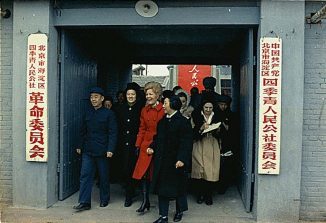
“This was the week that changed the world, as what we have said in that Communique is not nearly as important as what we will do in the years ahead to build a bridge across 16,000 miles and 22 years of hostilities which have divided us in the past,” Nixon said. One of the principal results was the Chinese agreeing to a peaceful solution to the Taiwan question, all the more desirable an outcome now since cables declassified in 2021 showed that we had nuclear weapons deployed in Taiwan at the time, ready to nuke every Chinese city in the case of an attack.
Also, accompanied by a swarm of television journalists, Nixon’s wife Pat got to show millions of Americans what Chinese life was like, by visiting factories, communities, hospitals, and parks, helping to break the stigma of “othering” which was rampant at the time. (1972)
158 years ago today, Lucy Hobbs became the first woman in the world to graduate from a dental college, and receive a doctorate in dentistry.
She was denied admittance to two medical colleges in Ohio due to her gender, but a professor agreed to tutor her and encouraged her to practice dentistry. After being denied admission to the Ohio College of Dentistry, a college graduate tutored her so she could continue her studies. Frustrated, she decided to open her own practice, and moved to Iowa in 1861 to do so. Four years later, the same Ohio College decided to lift the ban on women and, instantly, Taylor enrolled as a senior student thanks to her dentistry experience and got her diploma at age 33.
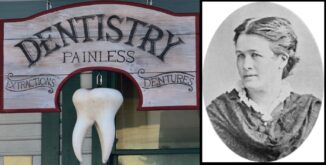
She also had a big and successful practice in Lawrence, Kansas with her husband James Taylor until 1886 when she left the field to become active in the campaign for women’s rights. But it was Lucy Hobbs Taylor’s passion and persistence in dentistry that broke the enamel ceiling for so many women in the future. (1866)
She wrote, “People were amazed when they learned that a young girl had so far forgotten her womanhood as to want to study dentistry.” But, by 1900, almost 1,000 women had followed in Lucy’s footsteps.
On this day 29 years ago, Steve Fossett, a 50-year-old stock broker from Chicago, became the first person to make a solo flight across the Pacific Ocean in a balloon. The American businessman, aviator, sailor, and adventurer landed in Saskatchewan, Canada, after taking off from South Korea—and he used the same balloon that successfully carried him across the Atlantic two years earlier. It was the first of many record-setting flights including seven years later when he became the first person to fly around the world alone, nonstop in any kind of aircraft—this time, in a 10-story high balloon for 13.3 days covering 20,482 miles.
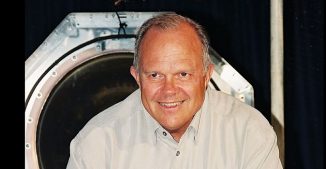
The man who made his fortune in the financial services industry also competed in endurance events like the Iditarod and Ironman Triathlon. He set records in four other nonstop circumnavigations of the Earth, as a sailor and solo pilot of a flight fixed-wing aircraft. Fortunately Fossett wrote an autobiography before he was killed in a crash in 2007 while piloting a light aircraft over the Great Basin Desert in California. WATCH his interview before the historic flight… (1995)
And Happy 81st Birthday to David Geffen, the head of Geffen Records and co-founder of Dreamworks. Born to immigrant parents in Brooklyn, the college drop-out began his entertainment career in the mailroom at the William Morris Agency, where he quickly became a talent agent. At age 27, Geffen co-founded Asylum records, an artist-oriented label that signed The Eagles, Joni Mitchell, Jackson Browne, Warren Zevon, Tom Waits, Linda Ronstadt, and (for 2 records) Bob Dylan. His philanthropy is renowned, with gifts of more than a half billion dollars in the fields of higher education, medical research, AIDS, the arts, and theatre. WATCH a video to learn more… (1943)
SHARE the Memories, Milestones, and Music…




















